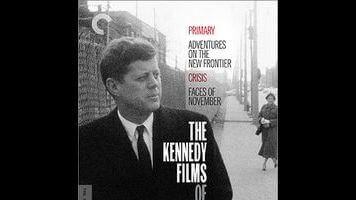Nowadays, anyone who can afford a smartphone carries a fairly decent video camera around with them 24/7, ready to shoot documentary footage at a moment’s notice. Half a century ago, by contrast, cameras that could shoot moving images were such clunky behemoths that the documentary as we know it today was more or less impossible. It was a group of enterprising filmmakers, led by Robert Drew (and including such future doc legends as Albert Maysles and D.A. Pennebaker), who worked out a means of reducing the necessary equipment to a bare minimum, allowing them to follow subjects around and capture events on the fly. Criterion’s new four-film set The Kennedy Films Of Robert Drew & Associates shows the medium’s rapid evolution over the few years of his presidential campaign and subsequent administration. Each film runs less than an hour (one is a 12-minute short), and they’re best watched in quick succession, the better to marvel at how speedily both the filmmakers and the politicians adapted to the new normal.
The best known of the four films is the earliest, Primary (1960), which observes Kennedy and his Democratic rival Hubert Humphrey as they battle for Wisconsin’s delegates. (Back then, primaries were optional for candidates; Lyndon Johnson, Kennedy’s most serious challenger at the convention, didn’t bother to run in any of them.) Frankly, the footage isn’t all that interesting, except in a basic historical sense. Drew’s new lightweight camera setup made it very difficult to record synchronous sound, so the film’s pictures and voices rarely match; the soundtrack just provides a general sense of the atmosphere. Consequently, there’s little of the behind-the-scenes strategizing that makes, say, The War Room so compulsively watchable. Primary’s significance lies in its primacy: It’s the first documentary that can truly be considered a fly-on-the-wall portrait, largely unmediated as it was filmed. The speeches and glad-handing are politics at its least compelling, but it’s possible to see how viewers were galvanized by the immediacy that we now take for granted.
As it turned out, Kennedy was a big fan of Primary (it helped that he won both Wisconsin and, later, the presidency), and allowed Drew and his team into the White House for a follow-up, which aired on ABC in 1961 with the title Adventures On The New Frontier. The film recycles some of Primary’s footage, and also flashes back to Kennedy’s inauguration, but mostly functions as a “day in the life” view, observing the president—who’d only been in office for six weeks—over 24 hours as he deals with various routine issues: budget requests, an airline strike, unemployment in West Virginia, the growth of communism in Africa. Just a year later, the technical facility is already much improved (sound is mostly in sync now) and while none of what Kennedy and his aides say or do is terribly exciting, Adventures On The New Frontier remains, to this day, the most extensive footage of mundane White House business ever recorded and assembled. It’s fascinating just to see Kennedy drumming his fingers on his knees absentmindedly during a briefing, as U.S. presidents of that era were mostly seen in carefully composed addresses delivered to the camera.
The set’s real humdinger, though, is Crisis: Behind A Presidential Commitment (1963), which preserves a key moment in American history. Not the Cuban Missile crisis, though, as one might assume—instead, Drew’s cameras were on hand as African-American students Vivian Malone and James Hood prepared to enter the University Of Alabama, knowing that Governor George Wallace had declared his intention of standing in the doorway himself and refusing to let them pass. Kennedy takes a back seat in this film to his brother, Robert, who was then attorney general; the candid footage of various phone calls and meetings includes a number of genuinely jaw-dropping moments, including sober discussion of whether Wallace should be physically picked up by the National Guard or just firmly shoved aside. Wallace happily talks to the camera as well, spouting his racist bullshit and insisting that posterity will judge him favorably as a man of great principle. (Bzzt!)
Crisis isn’t far removed from political docs as they exist today, which is astounding considered what the state of the art had been just five years earlier. And it was made before the White House realized that it maybe shouldn’t grant filmmakers quite that much access—though Kennedy did reportedly have veto power over anything that might make the government look bad. Had Kennedy survived and won a second term, who knows what wonders we might have seen? Five months after Crisis was shot, so was Kennedy; a few days later, Drew brought cameras to his funeral procession. The resulting short, Faces Of November, is a simple, wordless portrait of a traumatized nation, featuring one pain-stricken close-up after another. Few of the faces are familiar (Jackie and Bobby are seen mostly from a distance), but it doesn’t matter—each one clearly speaks for thousands. Without in any way planning it, Robert Drew and his associates pushed the form still further, into the realm of pure art.


 Keep scrolling for more great stories from A.V. Club.
Keep scrolling for more great stories from A.V. Club.